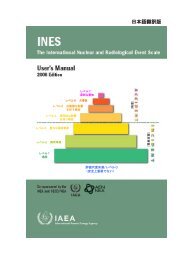Guidelines for Iodine Prophylaxis following Nuclear Accidents
Iodine_Prophylaxis_guide
Iodine_Prophylaxis_guide
You also want an ePaper? Increase the reach of your titles
YUMPU automatically turns print PDFs into web optimized ePapers that Google loves.
<strong>Guidelines</strong> <strong>for</strong> iodine prophylaxis <strong>following</strong> nuclear accidents1999 updateiodine administration, but instructions to take iodine tablets when predistributedshould be considered in planning.Evacuation will be decided upon primarily on the basis of plantconditions and meteorological data. However, plans should takeaccount of the fact that persons to be evacuated may have beenexposed to the radioactive cloud.5.2 ShelteringAdvising the population to stay indoors is a relatively simpleprotective measure in the early phase of an accident. The decision toimplement sheltering will be considered in nuclear emergencyplanning as a means of protection against external radiation as well asagainst inhalation of all radionuclides.Inhalation of radioactive iodine from a passing cloud will be reducedto some degree by sheltering indoors with closed windows and any<strong>for</strong>ced ventilation shut off, but sheltering is not completely effective inavoiding inhalation doses. Realistic dose estimates need to be takeninto account in considering plans <strong>for</strong> the implementation of stableiodine prophylaxis.It is important that planning <strong>for</strong> the simultaneous implementation ofstable iodine prophylaxis be seriously considered as a supplement tosheltering plans where the expected avertable inhalation dose to thethyroid approaches those in Table 1, and <strong>for</strong> those accidents whereradioactive iodine is a major component of the release.5.3 Food controlThe principal protective measures against internal exposure throughingestion are firstly, agricultural countermeasures (such as puttinggrazing animals on stored feed) followed by the banning of potentiallycontaminated foodstuffs or locally produced agricultural products. Forthis route of exposure or pathway, food control is generally preferableto the use of stable iodine prophylaxis.However, withholding milk from infants and young children will havedisadvantages and, in some circumstances, it may be <strong>for</strong>eseen that therapid distribution of uncontaminated milk to infants or transfer of16






